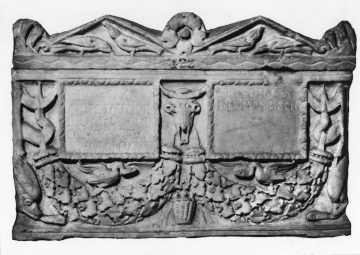Explore Collections


You are here:
CollectionsOnline
/
A Roman double funerary urn (cinerarium) and lid, carved with garlands held up by bukrania and dolphins at the lower front corners.
Browse
A Roman double funerary urn (cinerarium) and lid, carved with garlands held up by bukrania and dolphins at the lower front corners.
After Flavian period (see Sinn, p.60 cited below)
Pentelic marble
Height: 35cm
Height (excluding lid): 26cm
Width (lid): 52cm
Length (lid): 30cm
Height (excluding lid): 26cm
Width (lid): 52cm
Length (lid): 30cm
Inscription: 1) (LH side): D. M / Q. LICINIO. PR / ICO. CL. IASONIS / CONIVX. ET. Q / LICINIVS
D[is] M[anibus] Q[uinto] Licinio Prico Cl[audia] Iasonis coniu<n>x et Q[uintus] Licinius [fecerunt]
2) (RH side): CRISPINVS / FILIVS. B. M. F.
Crispinus filius b[ene] m[erens] f[ecit]
Inscription marks: 1) Line 1: 17mm; Line 2: 15mm; Lines 3-5: 14mm.
2) Lines 1-2: 14mm.
Inscription note: Solin dates this inscription to the second century A.D.
We are grateful to Dr. Charlotte Tupman, a scholar of epigraphy (the study of inscriptions) undertaking postdoctoral research at King’s College London, who took squeezes of the inscriptions on antiquities in the Museum in 2007, for her transliteration, translation and notes/bibliography of the inscription on this piece.
Inscription translation: 1) To the spirits of the departed. Quintus Licinius Pricus, Claudia Iasonis his wife and Quintus Licinius (set it up).
2) Crispinus his well-deserving son set it up.
D[is] M[anibus] Q[uinto] Licinio Prico Cl[audia] Iasonis coniu<n>x et Q[uintus] Licinius [fecerunt]
2) (RH side): CRISPINVS / FILIVS. B. M. F.
Crispinus filius b[ene] m[erens] f[ecit]
Inscription marks: 1) Line 1: 17mm; Line 2: 15mm; Lines 3-5: 14mm.
2) Lines 1-2: 14mm.
Inscription note: Solin dates this inscription to the second century A.D.
We are grateful to Dr. Charlotte Tupman, a scholar of epigraphy (the study of inscriptions) undertaking postdoctoral research at King’s College London, who took squeezes of the inscriptions on antiquities in the Museum in 2007, for her transliteration, translation and notes/bibliography of the inscription on this piece.
Inscription translation: 1) To the spirits of the departed. Quintus Licinius Pricus, Claudia Iasonis his wife and Quintus Licinius (set it up).
2) Crispinus his well-deserving son set it up.
Museum number: M422
On display: Catacombs
All spaces are in No. 13 Lincoln's Inn Fields unless identified as in No. 12, Soane's first house.
For tours https://www.soane.org/your-visit
Curatorial note
Between double fillets two name plates with egg and tongue mouldings, beneath which hang garlands suspended from reversed dolphins curled about the corners and an ox scull between. The dolphins pursue fish; geese appear above the garlands, and a basket of fruit between. Two birds in the pediments between antefixae and a rosette coil in the centre.
Inscribed: Left: D M Right: CRISPINVS
Q·LICINIO·PR FILIVS·B·M·F
ICO·CL·IASONIS
CONIVX·ET·Q
LICINIVS
Altmann1 provides a general classification by ornamentation for the type of rectangular urn represented by this and the previous examples, but this urn presents a modified complication in having the outside ends of the garlands supported by dolphin's tails instead of ox skulls (bukrania). According to Fridericke Sinn garlands were held up by dolphins on urns since Flavian times2. There are two other dolphin cinerary urns in the Soane collection S139 (Vermeule 336) and M406 (V337).
1 W. Altmann, Dir römischen Grabaltäre der Kaiserzeit, Berlin, 1905, Chapter VI, 'Das Girland-und Bukranienmotiv'.
2 On dolphins and their meaning in Roman art, see A. Rumpf, 'Die Meerwesen auf den antiken Sarkophagreliefs', ASR V I , 1939, pp. 98f and Toynbee, Animals in Roman Life and Art, 1973, pp. 206 ff.
Inscribed: Left: D M Right: CRISPINVS
Q·LICINIO·PR FILIVS·B·M·F
ICO·CL·IASONIS
CONIVX·ET·Q
LICINIVS
Altmann1 provides a general classification by ornamentation for the type of rectangular urn represented by this and the previous examples, but this urn presents a modified complication in having the outside ends of the garlands supported by dolphin's tails instead of ox skulls (bukrania). According to Fridericke Sinn garlands were held up by dolphins on urns since Flavian times2. There are two other dolphin cinerary urns in the Soane collection S139 (Vermeule 336) and M406 (V337).
1 W. Altmann, Dir römischen Grabaltäre der Kaiserzeit, Berlin, 1905, Chapter VI, 'Das Girland-und Bukranienmotiv'.
2 On dolphins and their meaning in Roman art, see A. Rumpf, 'Die Meerwesen auf den antiken Sarkophagreliefs', ASR V I , 1939, pp. 98f and Toynbee, Animals in Roman Life and Art, 1973, pp. 206 ff.
From Rome. Purchased by John Soane at Thomas Banks Sale, Christie's, 22 May 1805, £35.14s.0d.
Literature
Description of Sir John Soane's Museum, 1930, p.68, fig.37.
Corpus Inscriptionum Latinarum (CIS), VI, iii, 21293 (and bibliography).
H. Solin, Die Griechischen Personennamen im Rom. Ein Namenbuch, 2003, p. 534.
Corpus Inscriptionum Latinarum (CIS), VI, iii, 21293 (and bibliography).
H. Solin, Die Griechischen Personennamen im Rom. Ein Namenbuch, 2003, p. 534.
Soane collections online is being continually updated. If you wish to find out more or if you have any further information about this object please contact us: worksofart@soane.org.uk


